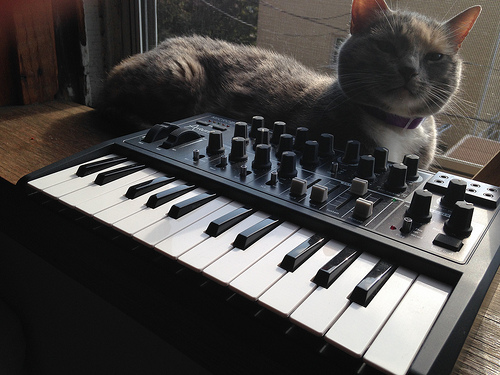
My First Analog Synth
[flickr id=”14251165036″ thumbnail=”medium” overlay=”true” size=”medium” group=”” align=”none”]
Just last month I added a great piece of gear to my home studio, an Arturia MicroBrute. This is my very first 100% analog synth, and so far I can say it has exceeded my expectations. Previously, my go-to hardware synth was the microKorg, a digital synthesizer modeled after retro analog synths. The microKorg is an impressive little machine as well, and for some projects I still prefer it over the MicroBrute.
[flickr id=”14087723417″ thumbnail=”medium_640″ overlay=”true” size=”medium_640″ group=”” align=”none”]
On the surface, the MicroBrute looks fairly simple. It only has one oscillator, one LFO, one filter, and is monophonic (plays one note at a time). However, the oscillator’s timbre can be easily manipulated with eight knobs, from basic triangle waves to ultra-sawtooth. The filter has three modes, high pass, low pass, and band pass. The sound of the filter is quite amazing, I like using it in combination with a saw-tooth wave with a lot of resonance. The filter can also be used with any line in source, so you can send a signal from your computer through the Brute to get an excellent analog filter effect. Also, the mod matrix allows for a great level of customization. This allows sending of the LFO and oscillator to pitch, filter, or to another synthesizer altogether. The one thing I wish was available was a basic sine wave, however the triangle wave with a low pass filter works fairly well.
Other obvious downsides to the Brute are that there is just one oscillator, and it has no presets. Well, it has presets, if you want to take time and mark each knob location on their rad preset sheets. I don’t really mind that there are no presets, it kind of gives it a mystical quality, and a challenge to remember how you created a sound in the past. It probably makes you a better synthesist as well.
[flickr id=”14294472903″ thumbnail=”medium” overlay=”true” size=”medium” group=”” align=”none”]
The Brute sounds warmer when compared to the Korg when I just listen to their simple sawtooth with filter sounds. The excellent resonance the Brute creates isn’t really created quite the same in the Korg. To see Bob Moog’s explanation of this issue, please take a look at this article from 2005. I believe virtual analog digital synths have gotten slightly better over the years. Great sounds can be achieved from U-He’s Zebra 2, but it doesn’t quite achieve the same warmth as analog. Digital synths can store endless presets, and are usually much easier to automate. The MicroBrute can receive midi notes, but can’t receive midi data for filter or LFO. This is one reason to use digital synths such as Zebra and the microKorg in addition to the Brute. For digital synths, having more than one oscillator or being polyphonic does not necessarily mean more expensive. Analog units can get pricey quickly, as each oscillator is a physical unit within the synth. Both analog and digital both have their place and time. I will be using the Brute for low end bass addition to orchestral pieces, doubling a melody with a nice warm synth tone, and using it as a bass synth alongside the Korg with my band for live performances.
To listen to some MicroBrute sounds, take a look at these soundcloud tracks.
